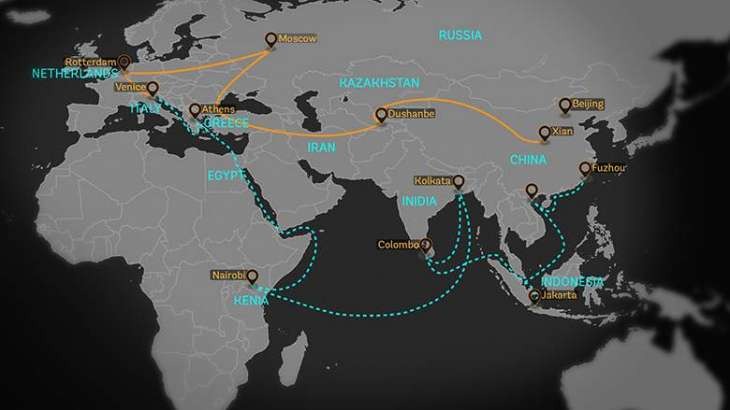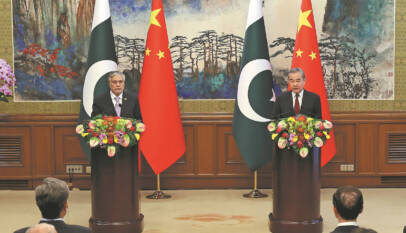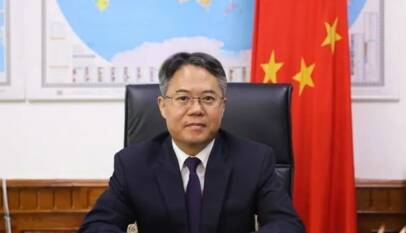China’s BRI ambitions are a masterstroke: Munir Ahmed
Munir Ahmed, a freelance journalist and broadcaster, Director Devcom-Pakistan, writes that BRI launched by President Xi Jinping defines the country’s vigour and drive for economic growth. He adds that it envisions the construction of road and sea connections between China and countries in Southeast Asia, Central Asia and through to Europe. He highlights that China has committed $1.4 trillion to the initiative, whereas Credit Suisse estimates that China can invest over $500 billion into 62 BRI projects by the end of 2021. He adds that the recent agreement between China and Iran calls for heavy Chinese investments in Iran over 25 years in exchange for oil — a step that can ease Iran’s international isolation. He adds that with this deal, Beijing has not only secured alternative access to hydrocarbons but has also further strengthened its influence across the Indian Ocean. This deal might come as a surprise for many given the Indian investments in Iran. Ahmed concludes by saying that the China-Iran accord is a masterstroke of China that will have a historic turnaround in the Middle East and Asia with global impact challenging the unilateral and hegemonic decision-making by the only ‘superpower’.
A country’s moves on the global strategic chessboard defines its vigor, present importance and projected future capacity. In recent years, the world has seen China’s gradual but rapid economic growth after the launch of ‘One Belt One Road’ (OBOR) initiative that was lately termed as the Belt and Road Initiative (BRI).
Launched by President Xi Jinping in 2013, the BRI envisions the construction of road and sea connections between China and countries in Southeast Asia, Central Asia and through to Europe. This is to be achieved with massive investment in infrastructure, including roads, rail, airports, ports, pipelines, and communications. China has committed $1.4 trillion to the initiative, which will leverage multiples of private finance to foot the bill for building and servicing the infrastructure. Credit Suisse estimates that China could invest over $500 billion into 62 BRI projects by the end of 2021.
The pandemic 2019, however, might have affected the pace of work on the BRI projects. But it seems not as the China signs a $400 billion deal with Iran for 25 years just about a week back. The deal is to ensure exchange of a steady supply of oil to fuel China’s growing economy under a sweeping economic and security agreement. The New York Times has termed the deal to deepen China’s influence in the Middle East. “The countries signed a sweeping pact on Saturday [March 27, 2021] that calls for heavy Chinese investments in Iran over 25 years in exchange for oil — a step that could ease Iran’s international isolation. But it was not immediately clear how much of the agreement can be implemented while the U.S. dispute with Iran over its nuclear program remains unresolved.”
President Biden has offered to resume negotiations with Iran over the 2015 nuclear accord that his predecessor, President Donald J. Trump, abrogated three years after it was signed. American officials say both countries can take synchronized steps to bring Iran into compliance with the terms of the agreement while the United States gradually lifts sanctions. Iran has refused to do so, and China has backed it up, demanding that the United States act first to revive the deal it broke by lifting unilateral sanctions that have suffocated the Iranian economy. China was one of five world powers that, along with the U.S., signed the 2015 nuclear agreement with Iran.
China-Iran accord as yet another masterstroke of China that would have a historic turnaround in the Middle East and Asia with global impact challenging the unilateral and hegemonic decision-making by the only ‘super power’
In these circumstances, the China-Iran accord is being termed as a historic milestone to further strengthen the Chinese influence in the Middle East region and Asia. It will not only extend the Chinese market for trade and economic growth but also be feared to disturb the balance of power in the region. The impact is expected to go beyond the region.
The $400 billion financial cooperation will help Iran to dilute its isolation and enhance trade ties with China and Middle East countries. At a time when Iran is struggling with the US sponsored restrictions and the devastating impact of Covid-19, this development is a welcome relief. However, it is questionable if the deal would lead to a win-win situation for all in the region and for the global stakeholders.
With this deal, Beijing has not only secured an alternative access to hydrocarbons but has also further strengthened its influence across the Indian Ocean. This deal might come as a surprise for many given the Indian investments in Iran. China has nurtured friendly bilateral relations with Iran over the decade and has signed over 17 agreements worth USD 18-20 billion and promised to increase trade relations between the two countries during President Xi Jinping 2016 visit to Iran. The deal discussed then got matured now.
This deal would be a big dent to the US interests in the region – a deal which is yet to be unfolded by Iran and China to the world. But experts believe that it may be largely unchanged from an 18-page draft obtained last year by The New York Times, as claimed and published.
That draft detailed $400 billion of Chinese investments to be made in dozens of fields, including banking, telecommunications, ports, railways, health care and information technology, over the next 25 years. In exchange, China would receive a regular — and, according to an Iranian official and an oil trader, heavily discounted — supply of Iranian oil. The draft also called for deepening military cooperation, including joint training and exercises, joint research and weapons development and intelligence-sharing.
Hesamoddin Ashena, a top adviser to President Rouhani, called the deal “an example of a successful diplomacy” on Twitter, saying it was a sign of Iran’s power “to participate in coalitions, not to remain in isolation.” He called it “an important decree for long-term cooperation after long negotiations and joint work.”
Chinese foreign minister Mr. Wang has already visited Iran’s archrival, Saudi Arabia, as well as Turkey, and is scheduled to go to the United Arab Emirates, Bahrain and Oman in the days ahead. He has said that the region is at a crossroads and offered China’s help in resolving persistent disputes, including over Iran’s nuclear program. China is even ready to play host to direct talks between the Israelis and the Palestinians, hinting that American dominance in the region has hindered peace and development.
While concluding, I must term the China-Iran accord as yet another masterstroke of China that would have a historic turnaround in the Middle East and Asia with global impact challenging the unilateral and hegemonic decision-making by the only ‘super power’.
Ambassador Zaidong highlights China’s embrace of innovation for sustainable development in Pakistan partnership
In recent months, the term “new quality productive forces” has sparked intense discussions…













